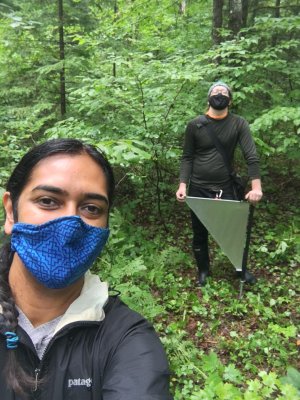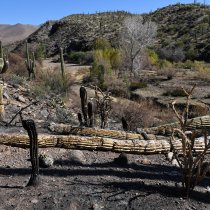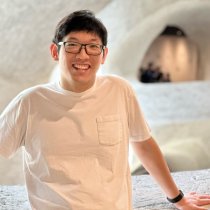Case Study
The Answers (to Fungal Spore Dispersal) Are Blowing in the Wind
September 2, 2020
Arbuscular mycorrhizal (AM) fungi are found in nearly every ecosystem, quietly helping plants absorb nutrients from the soil. Dr. Bala Chaudhary, an assistant professor of Environmental Science and Studies at DePaul University, wants to build a better model of how these vital ecosystem players disperse across the continent.
By using NEON’s Assignable Assets program, her work leverages NEON infrastructure to examine the role of aerial dispersal in AM fungal movement. Chaudhary and colleagues recently completed their dust collector installation tour across five of NEON’s Domains and plan to install more sensors across all 20 Domains in 2021.

Dr. Bala Chaudhary with Lab Manager and Research Assistant Paul Metzler on their dust collector installation tour to the NEON sites. Photo credit: Bala Chaudhary.
AM Fungi and the Microbiome of Plants
Arbuscular mycorrhizal fungi are a broad group of fungal species that form symbiotic relationships with plants. AM fungi live in the soil and penetrate the roots of most vascular plants, including grasses, forbs, and some trees. Within the roots, they form structures that help the plants absorb nutrients such as nitrogen and phosphorus from the soil. Mycorrhizal relationships are one of the most common forms of symbiosis on Earth.
Chaudhary explains that mycorrhizal fungi are an important part of the microbiome of the plant. “It’s like the human microbiome. We have a huge variety of microbial species that live in our guts, on our skin, and throughout our bodies that have a large impact on our biological functioning and health. The same is true for plants. AM fungi are an important part of the plant microbiome. They impact the health and functioning of individual plants and the ecosystem as a whole.”
Studying the Role of Aerial Dispersal in Fungal Movement
Chaudhary’s research focuses on how AM fungal spores are dispersed within and between ecosystems. AM fungi live entirely underground and do not produce fruiting bodies (like mushrooms) aboveground to spread spores. Spores must be carried along with soil-based dust in the wind or spread by small animals or other vectors. Chaudhary and her team of staff and students wanted to explore the role of wind in the dispersal of AM fungal spores.
Ultimately, she hopes to answer important questions such as:
- How do different spore traits (such as size and shape) correlate with their ability to be carried by the wind?
- How do different characteristics of the ecosystem (such as soil pH or texture or vegetation community composition) impact aerial dispersal of fungal spores?
- Do different ecosystem types (e.g., deserts vs. dense forests) enable more or less aerial dispersal of spores?
- What role does aerial dispersal play in the species composition of AM fungal communities in different parts of the country?
Leveraging NEON Infrastructure to Answer Questions About Fungal Dispersal
To answer these questions, Chaudhary is setting up specialized passive dust collectors at NEON core terrestrial field sites across the country. Her work leverages NEON tower and soil infrastructure through the NEON Assignable Assets program. Her NEON field project is part of a larger five-year National Science Foundation CAREER Award: Linking macroecology and traits to predict mycorrhizal fungal dispersal.
In the summer of 2020, Chaudhary and Paul Metzler, her research assistant and lab manager at DePaul, set up dust collectors at five NEON sites: Central Plains Experimental Range (CPER) and Niwot Ridge (NIWO) in Colorado, Konza Prairie Biological Station (KONZ) in Kansas, Woodworth (WOOD) in North Dakota and the University of Notre Dame Environmental Research Center (UNDE) in the upper peninsula of Michigan. In 2021 they plan to expand data collection to all 20 NEON Domains; travel restrictions due to COVID-19 prevented them from carrying out that plan this year. The five sites chosen for the 2020 pilot represent a range of ecosystem types, including grassland, forest, and alpine tundra.
The dust collectors are designed for long-term collection of particles carried by the wind. NEON technicians will ship the collected dust samples back to Chaudhary’s lab periodically. Chaudhary and her team of staff and students (graduate and undergraduate) will perform DNA analysis to identify the fungal species present in the dust. They will also analyze spore samples with a microscope and classify them by morphological traits such as size, color, and shape. This work is an extension of a previous study completed by Chaudhary and her team: Symbiotic underground fungi disperse by wind.
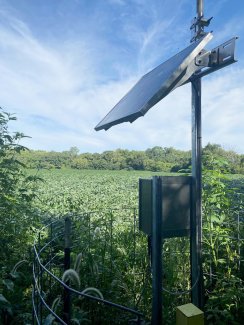
One of our ground water wells next to a soybean field at the NEON MCDI aquatic site. Photo credit: Becky Eaves.
The collectors are adjacent to NEON tower and soil infrastructure, which will enable Chaudhary to analyze her data along with data products collected by the NEON program, including soil sensor data, soil physical and chemical characteristics, and plant community composition. “Normally, I would not have access to this data, or I would have to go out and collect it myself,” she says. “Being able to piggyback off of the NEON infrastructure is incredibly helpful for a lab like mine. There are more data than I would have been able to gather by myself, and it expands the types of research questions we are able to ask.”
Predicting the Dispersal of AM Fungi
Chaudhary’s research could provide new insights into how AM fungi disperse and how spore dispersal impacts ecosystem function and health. It could also have implications for agriculture. Because of the role AM fungi play in nutrient uptake for crop plants, farmers often inoculate the soil with mycorrhizal fungi to adjust the soil microbiome. A better understanding of how and which kinds of AM fungi are dispersed naturally could enable development of more cost-effective and targeted bioinoculants – microorganisms that improve the nutrient availability in soil to plants.
Eventually, Chaudhary hopes to take her research worldwide. She and colleagues in the UK were funded to create a global dust collection network to study dispersal of fungal spores across continents.
In the meantime, she is excited about continuing and perhaps expanding her work with the NEON program. A discussion with a NEON wildlife scientist has piqued her interest in using NEON data and infrastructure to examine the role of small mammals in AM fungal spore dispersion. “NEON has given my lab the ability to do big science, much bigger than if we were to attempt it on our own,” she says.
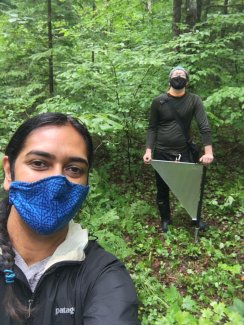
Dr. Bala Chaudhary with Lab Manager and Research Assistant Paul Metzler on their dust collector installation tour to the NEON sites. Photo credit: Bala Chaudhary
